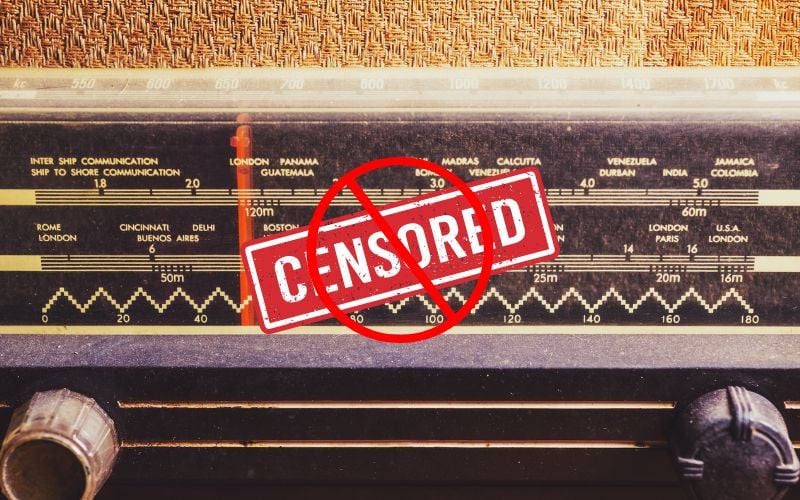For over a century, shortwave radio has bridged distances and connected the world. Today, it continues to captivate audiences with its unique blend of range and reliability.
What are the pros and cons of this amazing technology? This article will delve into the history, working principles, and future of shortwave radio. We also aim to weigh the benefits against their limitations.
What exactly is shortwave radio?

Shortwave radio is a radio transmission using shortwave frequencies, typically in the 3 to 30 MHz range. The frequency range allows shortwave radio to be transmitted over long distances, up to thousands of kilometers, making it a valuable tool for global communications.
You can use shortwave radio to listen to international broadcasts, including news, music, and entertainment programs.
Some shortwave radios even have features like Single Sideband (SSB) reception, which improves the audio quality you will hear.
The background and development of shortwave radios
The development of shortwave radios began in the early 1900s when the radio spectrum was categorized into three frequencies; Medium wave (MW), long wave (LW) and short wave (SW), depending on the wavelength of the signal.
The term “shortwave” came about because the wavelengths in this frequency range were shorter than 200 meters (1,500 kHz).
This was the initial upper limit of the medium frequency band used for radio communications.
In its early stages, long-distance radio telegraphy relied on long-wave signals with limited frequency availability and expensive transmitters and receivers.
By 1928, most long-distance communications had shifted from intercontinental cable and longwave wireless services to shortwave, which was less expensive and more efficient.
In the 1920s, shortwave communications experienced rapid growth.
People all over the world used shortwave radio to listen to funny shows and broadcasts. Shortwave radios played a significant role in connecting the world by enabling communication.
Technology has advanced since then, and shortwave radio’s popularity has waned.
Nonetheless, it left an indelible mark on our history, helped bring the world together for so long, and has remained a reliable source of information.
What is the principle behind shortwave radio technology?

The principle of operation of shortwave radio technology depends on the behavior of radio waves, which are a type of electromagnetic radiation.
Shortwave radio signals travel at higher frequencies than AM or FM radio.
Also, due to the unique properties of shortwave frequencies, these signals can travel great distances. When a shortwave radio signal is sent, it goes out into the atmosphere.
It can ricochet off the ionosphere, a layer of electrically charged particles in the upper atmosphere.
This property allows the signal to be received by listeners thousands of miles from the source, making it a useful tool for global communications.
On the receiving end, shortwave radio has an antenna that picks up the incoming signal. The signal then goes through a radio frequency amplifier, which boosts the signal strength.
Next, a demodulator converts the signal from analog to digital.
Finally, the sound of the digital signal is played through the radio’s speaker for you to hear.
The advantages and disadvantages of shortwave radio
Advantages of shortwave radio
Here are some of the reasons why you should invest in a shortwave radio.
Easy to purchase
Inexpensive shortwave radios can be obtained in practically all but a few countries with overwhelming restrictions.
It is also easy to construct basic regenerative shortwave tuners with a small number of components.
Battery powered
Many modern shortwave radios are compact and can run on batteries, making them useful in tricky situations.
Advanced designs include hand and solar powered radios that generate electricity without relying on batteries.
Censor-proof

The technical difficulties in determining which channels are monitored make it difficult for authorities in restrictive countries to censor programming.
This offers a tremendous benefit to shortwave radio, as the technology allows information to be transmitted to virtually any part of the world.
Accessible
Shortwave radio ownership extends to numerous nations, including underdeveloped and developed nations.
This makes it an easily accessible medium for a wide listener base.
Simple infrastructure
Its minimal infrastructure makes it a reliable means of communication that you can build together.
A mere set of antennas and transceivers can serve as an efficient, long-range, two-way communication mode.
Thus, shortwave is a reliable form of communication that cannot be affected by interference or unfavorable ionospheric circumstances.
remote transmission
Shortwave’s long-distance transmission capability allows broadcasts to travel thousands of miles across continents.
This makes it a suitable form of communication to reach a wider audience over long distances compared to a VHF broadcast with a limited range.
Reliable communication mode
Shortwave can be available when other forms of communication such as satellite communications, internet, telephone or television are unavailable or too expensive.
This makes it a reliable means of communication in times of crisis or in remote areas where other forms of communication may not be available.
Additionally, the incorporation of advanced digital transmission techniques can improve reliability by enabling successful signal acquisition even in noisy environments.
Weatherproof and cheap
The insensitivity of shortwave to thunderstorm interference in tropical regions distinguishes it from mediumwave radio.
In addition, it can serve a huge geographic area with relatively little energy expenditure, making it a cost-effective option for local broadcasting.
Hence, it is a preferred choice for communication in many tropical countries.
Disadvantages
May not be fully reliable

Interference and mode usage can limit the audio quality of shortwave radio. This in turn limits its reliability, especially in areas of high interference.
Again, its signal is weaker than local FM signals, while its sound is typically monophonic. This is poor sound quality that cannot compete with modern communication technologies.
Not viable in developed areas
In developed countries, there is likely to be interference from electronic equipment such as computers, Internet modems, light sources, and power supplies. This can make shortwave signals quite difficult to pick up.
This in turn makes shortwave radio a less than ideal means of communication in densely populated areas with a high proliferation of electronics.
Less popular
Only enthusiasts own these types of radios, especially in western countries.
Also, many of the current radios lack shortwave reception capabilities. Therefore, the popularity of the technology has declined significantly.
Decreased listener attention
In most countries, particularly in highly developed countries, there is a significantly limited listener base for shortwave radio. This is because there are more fascinating technologies such as television and the internet.
Anyone considering investing in a shortwave broadcaster may find it difficult to build a customer base.
The potential future of shortwave radio
The future of shortwave radios looks promising, but at the same time uncertain.
With advances in technology and increasing interest in alternative modes of communication, shortwave radios are experiencing something of a revival.
Interference due to PLC frequencies
The need for shortwave receivers has decreased with the further development of direct satellite broadcasting. Nonetheless, a significant number of shortwave transmitters remain.
However, the growth of power line communications (PLC) could challenge shortwave radio.
PLC frequencies match shortwave frequencies and can cause severe interference, making shortwave radio signals difficult to hear near power lines.
Still reliable
Shortwave remains the most accessible international communication and offers listeners complete anonymity.
Shortwave radio may still have a place in areas prone to natural disasters in the 21st century as it can reach areas where local broadcasting and internet infrastructure is not available.
In terms of technology, we can expect shortwave radios to become more compact, lighter and feature rich.
In addition, with the advent of digital signal processing, shortwave radios are becoming easier to use and offer improved sound quality.
Integration with modern devices
There is also a trend to integrate shortwave radios with other devices such as smartphones and car stereo systems to make them even more accessible to a wider audience.
This means the technology is here to stay and will likely only get better and more accessible.
Final Thoughts
Shortwave radio offers a wealth of benefits, including global reach, emergency communications and access to diverse programming.
However, it also has disadvantages such as B. potential interference, the need for special equipment and the decline in usage due to technological advances.
As for the future of shortwave radio, it remains to be seen how it will evolve with advances in communications technology. Despite its challenges, however, shortwave radio remains a valuable resource for those who rely on it for communication and entertainment.

